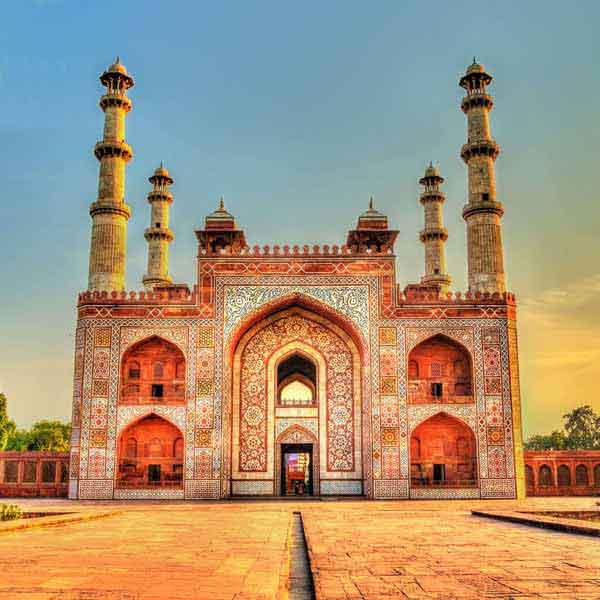Sikandra/Akbar’s Tomb Located in the western periphery of the city, the red-sandstone and marble tomb was built by Emperor Akbar, which was later completed by his son Jahangir. Its interior is covered with exquisite calligraphy that reflects the tenets of Din-e-Ilahi, a religious movement started by Emperor Akbar based on the fusion of primarily Hinduism and Islam including other religions as well. Sikandra is the resting place of the Mughal emperor Akbar and his grave lies here in a dark chamber. The outlying garden which is laid out in the Char Bagh style is yet another attraction of the place.
The story behind Akbar’s Tomb is different from that of The Taj Mahal. Shahjahan started Taj Mahal’s construction for his wife Mumtaj so it is the mausoleum of Mumtaz Mahal especially. But the construction of Akbar’s Tomb Agra was commenced by Badshah Akbar himself to keep his sepulture. There are only few Tombs of this type in the world with such a great story behind the purpose of their construction.
The real Tomb of Akbar the Great is situated in the basement which is unfortunately not open for tourist for security reasons. The basement has panels, places to pass air and an open door where the actual body of Mughal Emperor Akbar is kept as per the mughal traditions.

The entire complex of Akbar’s Tomb is covered by thick walls from all sides and has four gates but only southern gate is being used for entry and exit which is the largest and enriched with vast work of architecture, all other gates are almost ruined. Akbar's Tomb has huge garden inside where you can easily spot wild animals like antelope, monkeys and peacocks. In fact the real beauty of Akbar's Tomb is the greenery and the animals roaming here and there inside the premises. Lush green surroundings with some wild life gives this tomb a unique identity in the city of cultural heritage.
History of Akbar's Tomb
Emperor Akbar while he was alive selected the place for his final resting place, the design of the gardens around the tomb and took care of the construction of his own tomb. While the entire tomb was constructed and Akbar lived through it, his son, Emperor Jehangir famously known as Prince Salim constructed a floor of marble stone over the structure. Thus, he completed the structure of his Emperor father’s tomb.
Aurangazeb was known as a tough and strict or ruthless leader who offended the feelings of many Hindus. Many temples were destroyed during his reign and this led to a massive revolt by the Jats. To take revenge for the death of his father, the Raja Ram Jat ordered the revolt and attacks against this king. So, they attacked the massive Agra Fort and took away huge amounts of ornaments, jewelery, precious stones and precious metals, diamonds, carpets, etc. They also burnt and even cremated the bones of Emperor Akbar that was totally unacceptable.
Architecture of Akbar's Tomb
The tomb of Akbar is done in typical style and symmetry of various monuments during the Mughal era. This monument is the perfect symbol of Mughal architecture. However, there are also features of Rajputana and Gothic style of architecture. It has four minarets similar to the Taj Mahal’s minarets, at the largest gate. The southern gate is the largest of the four gates of this tomb and is the general gate for entry. There are total of four storeys and it is enclosed within a large wall around the tomb.
Best time to visit Akbar's Tomb
The tomb is open from 6 in the morning to 6:30 in the evening. The monument is at its prime beauty throughout the year. However, people choose winter, as it will be pleasing with mild climate. If you are visiting during rainy season, you will not be able to spot any animals inside the complex.